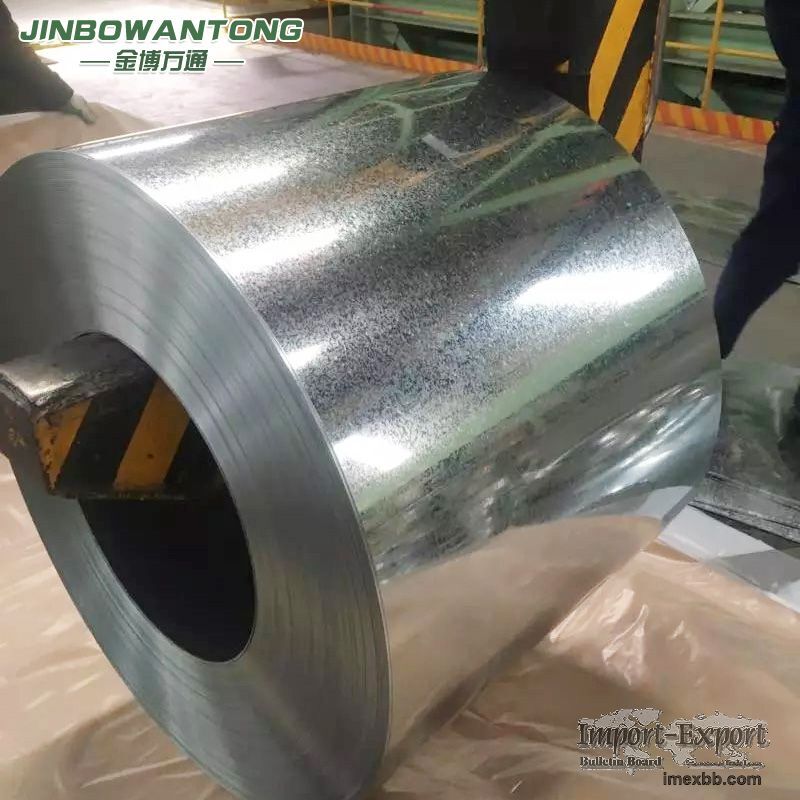 |
 |
Home > Offers to Sell > Minerals & Metals > Metal Products > Other Metal Products
| Contact: | Jerry Lin |
|---|---|
| Company: | QINGDAO JINBOWANTONG INTERNATIONAL TRADE CO.,LTD. |
| Xingfu steel market | |
| Binzhou | |
| China | |
| Phone: | 18954339718 |
| E-Mail: | |
| Date/Time: | 10/10/23 1:04 GMT |
Hot-dipped Galvanized Steel Coils(GI)
Galvanized steel coil is based on cold-rolled steel strip as substrate, after
continuous hot-dip galvanizing process and produced products. This method
tightly adheres the coating to the steel with an iron-zinc alloy bonding layer
formed by a diffusion process while the heated steel strip is in contact with
the molten zinc. It is an excellent resistance to atmospheric corrosion of
coated steel. cold-rolled sheet after the zinc can extend the service life for
15-20 years. Galvanised steel coils are successfully used in industries with
stringent requirements for corrosion resistance, durability, strength and
appearance, and can be formed or have various coatings applied. The key
standards to be followed for the production of galvanised coils include EN
10346 (Europe), ASTM A653 / A653M (US). Manufacturers also have their own
original standards.
Hdg coil classification, product range and properties
Standards applied in different countries to set the requirements for hot dipped
galvanized steel coils specify steel grade and size ranges for these products.
Hot dipped galvanised coils are classified based on the following features:
Application of coated steel (profiling, cold forming, manufacture of steel
structures)
Chemical composition of coating material (pure zinc, zinc-iron/zinc-
aluminium/aluminium-zinc/zinc-m , agnesium alloys, etc)
Thickness/weight of protective coating
►HDG coils according to European standards
Galvanised steel coils as per the European EN 10346, can be coated with zinc,
zinc-iron alloy, zinc-aluminium alloy, aluminium-zinc alloy or aluminium-
silicon alloy:
Zinc coating (Z) is achieved by dipping the prepared strip into a bath with
molten alloy, containing at least 99% zinc. This is the most common and
traditional way of protecting rolled steel from corrosion.
Zinc-iron coating (ZF) is formed by dipping a strip into a bath of molten zinc
(at least 99% zinc) with further annealing to form a zinc-iron coating with an
Fe content of 8-12%. Such coating is stronger than the traditional zinc coating
and has better adhesion with substrate steel due to mutual diffusion between
the iron and zinc in the surface layers. That is why this coating is less
exposed to lamination or pitting under impact, mechanical stresses or
deformation of treated products.
Zinc-aluminium coating (ZA) is applied to rolled steel by dipping it into a
bath of zinc and about 5% aluminium with a minor content of mishmetal (mix of
metals). Rolled steel with such coating has better formability and corrosion
protection properties compared with zinc-coated steel.
Aluminium-zinc coating (AZ) is applied by dipping steel into a bath of molten
metal consisting of 55% aluminium and 1. 6% silicon (with the remaining being
taken up by zinc). The combined action of these metals ensures the best
corrosion protection compared with other coatings.
Aluminium-silicon coating (AS) is created by dipping steel into a bath of
molten metal containing aluminium and 8-11% silicon. Galvanized steel coil with
such coating is highly resistant to oxidation at high temperature (up to
650°C) and highly resistant to chemical corrosion.
Galvanised steel coils manufactured according to the EN 10346 can be made from
the following steels:
Low-carbon steel for cold forming (DX51D – DX57D). These products are
classified based on suitability for cold forming: DX51D – bending and
profiling quality; DX52D – drawing quality; DX53D – deep-drawing quality;
DX54D – special deep-drawing quality; DX55D – special deep-drawing quality
(only +AS); DX56D – extra deep drawing quality; DX57D – super deep drawing
quality.
Steel for construction and framing (S220GD – S550GD). Rolled products are
arranged in increasing yield stress (Rp0. 2), which is indicated in the
marking. Rolled products of S220GD – S550GD steel are mainly used in the
manufacture of formed sections (Z-, C-, sigma-, U-shaped profiles, etc) for
light-gauge steel structures.
Steel with high yield strength for cold forming (HX160YD, HX180YD, HX180BD,
HX220YD, HX300LAD, etc). Such rolled products are arranged in increasing yield
stress (Rp0. 2), which is indicated in the marking. The marking also contains
the following information: H – high-strength flat rolled products for cold
forming; Х – as-rolled condition (hot-rolled or cold-rolled) is not defined;
D – designed for hot-dip coating; B – heat-treated steel; Y – steel with
higher formability; LA – low-alloy / micro-alloy steel.
Cold-formable multi-phase steel (HDT450F, HCT490X, HDT590X, HCT780X, HCT980X,
HCT780T, HDT580X, etc). Rolled products are arranged in increasing minimum
tensile strength (Rm0. 2), which is indicated in the marking. The marking also
contains the following information: H – high-strength flat-rolled products for
cold forming; С – cold-rolled products; D – hot-rolled products; Т (nnn) –
the minimum tensile strength in MPa. The last symbol: F – ferrite-bainite, Х
– dual-phase; Т – TRIP, С – complex-phase; М – martensite.
Galvanised coils as per the EN 10346 standard can be coated with zinc, zinc-
iron alloy, zinc-aluminium alloy, aluminium-zinc alloy or aluminium-silicon
alloy. The coating weight is expressed as grams per square metre and
characterises the weight of the coating deposited on the both strip surfaces.
The coating type (Z, ZF, ZA, AZ, AS) and nominal weight are indicated in the
coating designation. Depending on the type of protective layer, the minimum
weight of coating on both surfaces of a galvanized product can be 100-600 g/m2
(average value for three spots).
https://www.jinbosteel.com/
SOURCE: Import-Export Bulletin Board (https://www.imexbb.com/)
Similar Products:Not exactly what you are looking for? Post an Offer to Buy!
![]()
© 1996-2010 IMEXBB.com. All rights reserved.
|
|
|






